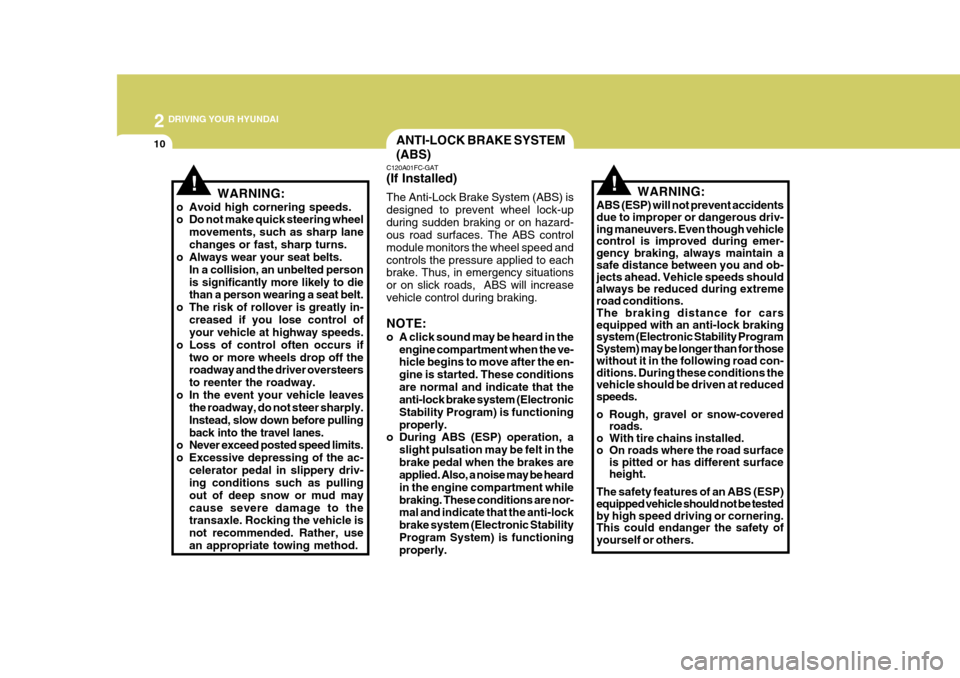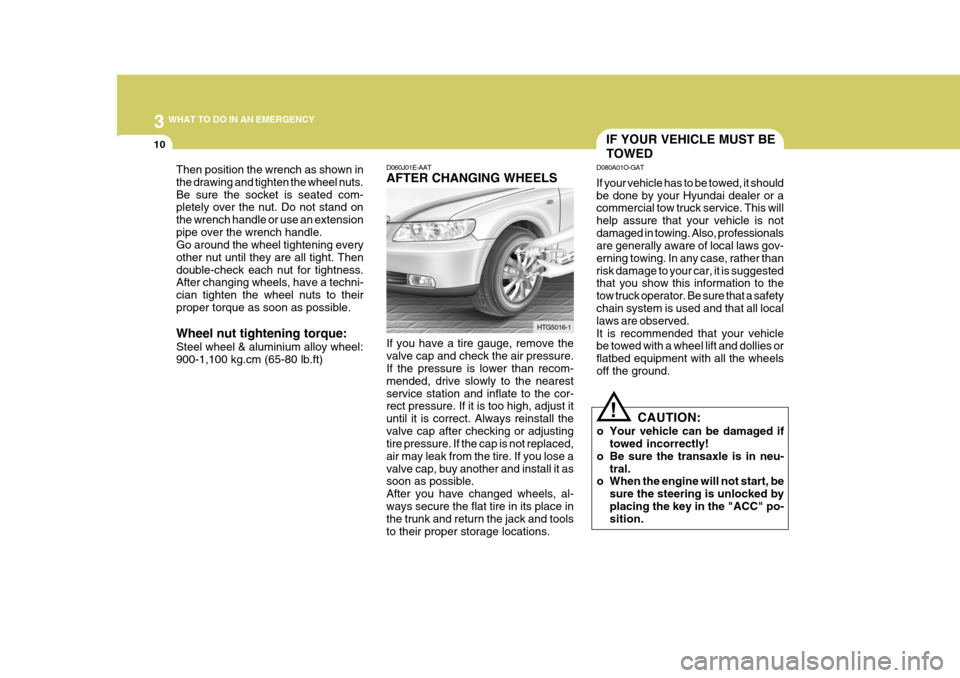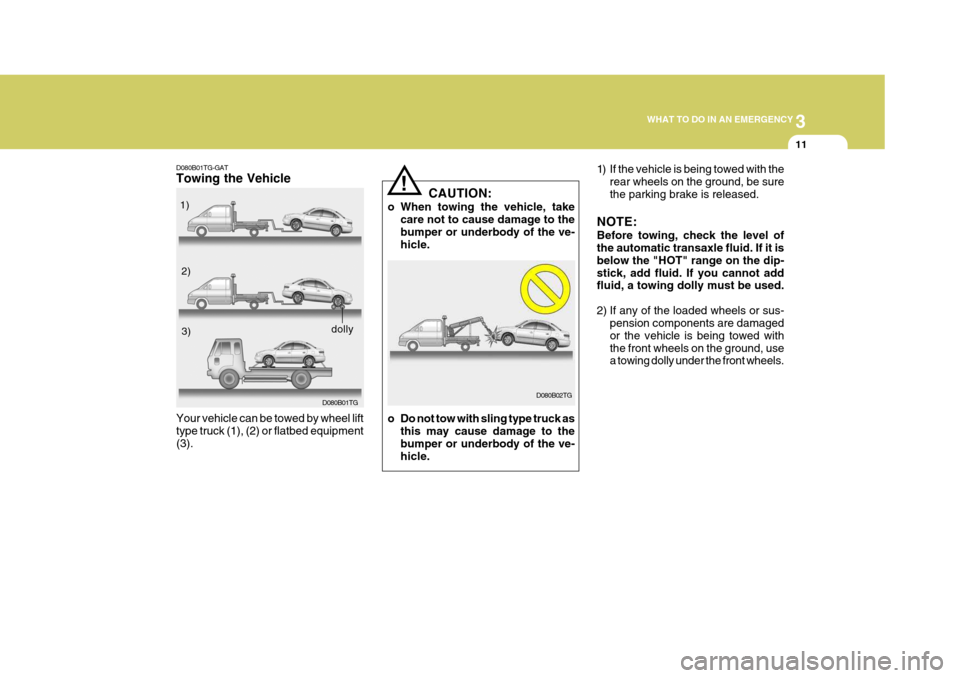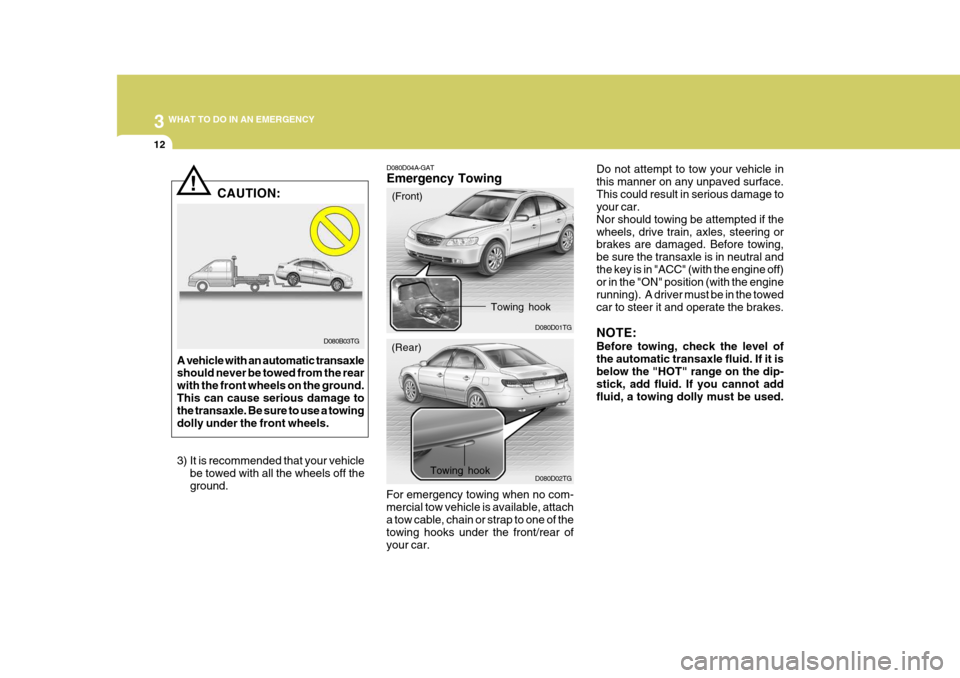2005 Hyundai Azera emergency towing
[x] Cancel search: emergency towingPage 194 of 297

2 DRIVING YOUR HYUNDAI
10
!!
ANTI-LOCK BRAKE SYSTEM (ABS)
C120A01FC-GAT (If Installed) The Anti-Lock Brake System (ABS) is designed to prevent wheel lock-upduring sudden braking or on hazard- ous road surfaces. The ABS control module monitors the wheel speed andcontrols the pressure applied to each brake. Thus, in emergency situations or on slick roads, ABS will increasevehicle control during braking. NOTE:
o A click sound may be heard in the
engine compartment when the ve- hicle begins to move after the en- gine is started. These conditionsare normal and indicate that the anti-lock brake system (Electronic Stability Program) is functioningproperly.
o During ABS (ESP) operation, a
slight pulsation may be felt in thebrake pedal when the brakes are applied. Also, a noise may be heard in the engine compartment whilebraking. These conditions are nor- mal and indicate that the anti-lock brake system (Electronic StabilityProgram System) is functioning properly. WARNING:
ABS (ESP) will not prevent accidents due to improper or dangerous driv-ing maneuvers. Even though vehicle control is improved during emer- gency braking, always maintain a safe distance between you and ob- jects ahead. Vehicle speeds should always be reduced during extreme road conditions. The braking distance for cars equipped with an anti-lock braking system (Electronic Stability Program System) may be longer than for those without it in the following road con- ditions. During these conditions the vehicle should be driven at reduced speeds.
o Rough, gravel or snow-covered roads.
o With tire chains installed.
o On roads where the road surface is pitted or has different surfaceheight.
The safety features of an ABS (ESP)equipped vehicle should not be tested by high speed driving or cornering. This could endanger the safety of yourself or others.
WARNING:
o Avoid high cornering speeds.
o Do not make quick steering wheel movements, such as sharp lane changes or fast, sharp turns.
o Always wear your seat belts.
In a collision, an unbelted personis significantly more likely to die than a person wearing a seat belt.
o The risk of rollover is greatly in-
creased if you lose control ofyour vehicle at highway speeds.
o Loss of control often occurs if
two or more wheels drop off theroadway and the driver oversteers to reenter the roadway.
o In the event your vehicle leaves the roadway, do not steer sharply.Instead, slow down before pullingback into the travel lanes.
o Never exceed posted speed limits.
o Excessive depressing of the ac-
celerator pedal in slippery driv- ing conditions such as pulling out of deep snow or mud maycause severe damage to the transaxle. Rocking the vehicle is not recommended. Rather, usean appropriate towing method.
Page 208 of 297

3
If the Engine Will not Start ............................................ 3-2
Jump Starting ............................................................... 3-3
If the Engine Overheats ............................................... 3-4
Spare Tire .................................................................... 3-5
If You Have a Flat Tire ................................................. 3-6
Changing a Flat Tire .................................................... 3-6
If Your Vehicle Must Be Towed ..................................3-10
Emergency Towing ..................................................... 3-12
If You Lose Your K eys ................................................ 3-13
WHAT TO DO IN AN EMERGENCY
3
Page 217 of 297

3 WHAT TO DO IN AN EMERGENCY
10
Then position the wrench as shown in the drawing and tighten the wheel nuts.Be sure the socket is seated com- pletely over the nut. Do not stand on the wrench handle or use an extensionpipe over the wrench handle. Go around the wheel tightening every other nut until they are all tight. Thendouble-check each nut for tightness. After changing wheels, have a techni- cian tighten the wheel nuts to theirproper torque as soon as possible. Wheel nut tightening torque: Steel wheel & aluminium alloy wheel: 900-1,100 kg.cm (65-80 lb.ft) D060J01E-AAT AFTER CHANGING WHEELS If you have a tire gauge, remove the valve cap and check the air pressure. If the pressure is lower than recom- mended, drive slowly to the nearestservice station and inflate to the cor- rect pressure. If it is too high, adjust it until it is correct. Always reinstall thevalve cap after checking or adjusting tire pressure. If the cap is not replaced, air may leak from the tire. If you lose avalve cap, buy another and install it as soon as possible. After you have changed wheels, al-ways secure the flat tire in its place in the trunk and return the jack and tools to their proper storage locations.HTG5016-1
IF YOUR VEHICLE MUST BE TOWED
D080A01O-GAT If your vehicle has to be towed, it should be done by your Hyundai dealer or a commercial tow truck service. This will help assure that your vehicle is notdamaged in towing. Also, professionals are generally aware of local laws gov- erning towing. In any case, rather thanrisk damage to your car, it is suggested that you show this information to the tow truck operator. Be sure that a safetychain system is used and that all local laws are observed. It is recommended that your vehicle be towed with a wheel lift and dollies or flatbed equipment with all the wheelsoff the ground.
! CAUTION:
o Your vehicle can be damaged if towed incorrectly!
o Be sure the transaxle is in neu- tral.
o When the engine will not start, be
sure the steering is unlocked by placing the key in the "ACC" po- sition.
Page 218 of 297

3
WHAT TO DO IN AN EMERGENCY
11
D080B01TG-GAT Towing the Vehicle
D080B01TG
Your vehicle can be towed by wheel lift type truck (1), (2) or flatbed equipment(3). 1)
2)3)
dolly
CAUTION:
o When towing the vehicle, take care not to cause damage to the bumper or underbody of the ve- hicle. 1) If the vehicle is being towed with the
rear wheels on the ground, be surethe parking brake is released.
NOTE: Before towing, check the level of the automatic transaxle fluid. If it is below the "HOT" range on the dip-stick, add fluid. If you cannot add fluid, a towing dolly must be used.
2) If any of the loaded wheels or sus- pension components are damaged or the vehicle is being towed withthe front wheels on the ground, use a towing dolly under the front wheels.
D080B02TG!
o Do not tow with sling type truck as this may cause damage to the bumper or underbody of the ve- hicle.
Page 219 of 297

3 WHAT TO DO IN AN EMERGENCY
12
D080D04A-GAT Emergency Towing
For emergency towing when no com- mercial tow vehicle is available, attacha tow cable, chain or strap to one of the towing hooks under the front/rear of your car. D080D01TG
!
D080B03TG
CAUTION:
A vehicle with an automatic transaxle should never be towed from the rear with the front wheels on the ground.This can cause serious damage to the transaxle. Be sure to use a towing dolly under the front wheels.
3) It is recommended that your vehicle be towed with all the wheels off the ground. D080D02TGDo not attempt to tow your vehicle in this manner on any unpaved surface.This could result in serious damage to your car. Nor should towing be attempted if thewheels, drive train, axles, steering or brakes are damaged. Before towing, be sure the transaxle is in neutral andthe key is in "ACC" (with the engine off) or in the "ON" position (with the engine running). A driver must be in the towedcar to steer it and operate the brakes. NOTE: Before towing, check the level of the automatic transaxle fluid. If it isbelow the "HOT" range on the dip- stick, add fluid. If you cannot add fluid, a towing dolly must be used.
(Front)
(Rear) Towing hook
Towing hook
Page 296 of 297

10
INDEX
5
O Odometer ................................................................... 1-72
P Parking Brake .......................................................... 1-100
Checking the parking brake pedal ..........................6-21
Power Outlet .............................................................. 1-86
Power Steering Fluid Level ........................................ 6-25
RRear Seat Adjustable headrests .............................................. 1-29
Folding rear seatbacks ........................................... 1-29
Rear seatback safety lock ...................................... 1-30
Rear Window Curtain ............................................... 1-108
S Seat ........................................................................... 1-20
Front ....................................................................... 1-21
Rear ........................................................................ 1-29
Seat Belts
3-Point system ....................................................... 1-33
Adjusting your seat belt .......................................... 1-35
Care of seat belts ................................................... 1-32
Pre-tensioner seat belt ........................................... 1-43
Precautions ............................................................. 1-31
Seat Warmer ............................................................. 1-28
Seatback Pocket ....................................................... 1-89
Shift Lock Release ...................................................... 2-9
Spark Plugs ................................................................. 6-9 Spectacle C
ase ......................................................... 1-94
Speedometer ............................................................. 1-71
Starting Procedure ....................................................... 2-3
Steering Wheel Free-play ................................................................. 6-20
Tilt and tel escopic ................................................ 1-108
Stereo Sound System ............................................. 1-133
Sun Visor ................................................................. 1-106
Sunroof ...................................................................... 1-89
TTachometer ................................................................ 1-72
Theft-Alarm System .................................................. 1-13
Tires Balancing .................................................................. 8-5
Chains ...................................................................... 8-4
Changing a flat tire ................................................... 3-6
If you have a flat tire ................................................ 3-6
Information ................................................................ 8-2
Pressure ................................................................... 8-2
Replacement ............................................................. 8-5
Rotation .................................................................... 8-4
Snow tires ................................................................ 8-3
Spare tire .................................................................. 3-5
Traction ..................................................................... 8-5
Towing A trailer or vehicle .................................................. 2-19
Emergency ............................................................. 3-12
If your vehicle must be towed ................................ 3-10